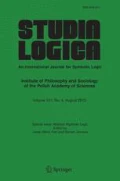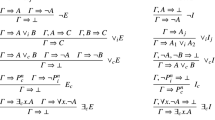Abstract
New propositional and first-order paraconsistent logics (called L ω and FL ω , respectively) are introduced as Gentzen-type sequent calculi with classical and paraconsistent negations. The embedding theorems of L ω and FL ω into propositional (first-order, respectively) classical logic are shown, and the completeness theorems with respect to simple semantics for L ω and FL ω are proved. The cut-elimination theorems for L ω and FL ω are shown using both syntactical ways via the embedding theorems and semantical ways via the completeness theorems.
Similar content being viewed by others
References
Almukdad A., Nelson D. (1984) ‘Constructible falsity and inexact predicates’. Journal of Symbolic Logic 49(1): 231–233
Anderson, A.R., and N.D. Belnap, Entailment: The logic of relevance and necessity, Vol. I, Princeton University Press, Princeton, NJ, 1975.
Arieli O., Avron A. (1996) ‘Reasoning with logical bilattices’. Journal of Logic, Language and Information 5: 25–63
Belnap, N.D., ‘A useful four-valued logic’, in J. M. Dunn and G. Epstein (eds.), Modern Uses of Multiple-Valued Logic, Reidel, Dordrecht, 1977, pp. 5–37.
Dunn J.M. (1976) ‘Intuitive semantics for first-degree entailment and ‘coupled trees’’. Philosophical Studies 29(3): 149–168
Gargov G. (1999) ‘Knowledge, uncertainty and ignorance in logic: bilattices and beyond’. Journal of Applied Non-Classical Logics 9: 195–283
Kamide N. (2004) ‘A relationship between Rauszer’s H-B logic and Nelson’s logic’. Bulletin of the Section of Logic 33(4): 237–249
Kamide N. (2005) ‘Gentzen-type methods for bilattice negation’. Studia Logica 80(2-3): 265–289
Kamide N. (2005) ‘A cut-free system for 16-valued reasoning’. Bulletin of the Section of Logic 34(4): 213–226
Shramko Y., Dunn J.M., Takenaka T. (2001) ‘The trilattice of constructive truth values’. Journal of Logic and Computation 11(6): 761–788
Shramko Y., Wansing H. (2005) ‘Some useful 16-valued logics: how a computer network should think’. Journal of Philosophical Logic 34(2): 121–153
Shramko Y., Wansing H. (2006) ‘Hyper-contradictions, generalized truth values and logics of truth and falsehood’. Journal of Logic, Language and Information 15(4): 403–424
Takeuti, G., Proof theory, North-Holland Pub. Co., 1975.
Wansing, H., ‘The logic of information structures’, Lecture Notes in Artificial Intelligence 681, Springer-Verlag, 1993, pp. 1–163.
Author information
Authors and Affiliations
Corresponding author
Additional information
Presented by Yaroslav Shramko and Heinrich Wansing
Rights and permissions
About this article
Cite this article
Kamide, N. Proof Systems Combining Classical and Paraconsistent Negations. Stud Logica 91, 217–238 (2009). https://doi.org/10.1007/s11225-009-9173-6
Received:
Revised:
Accepted:
Published:
Issue Date:
DOI: https://doi.org/10.1007/s11225-009-9173-6




